Mitsubishi Outlander Sport (2022 year). Manual in english - page 7
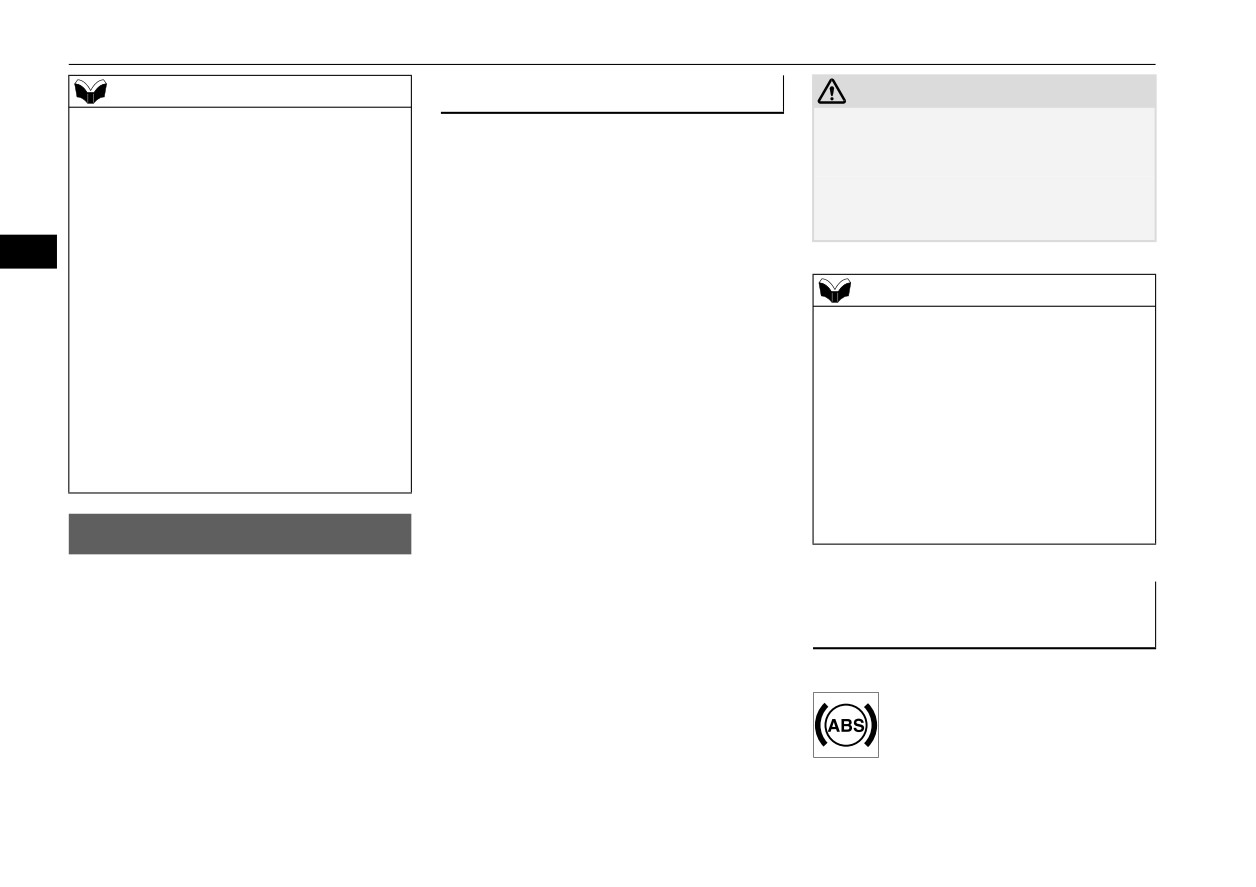
Anti-lock braking system
NOTE
Driving hints
CAUTION
z
When the brake assist system is in use while
z
The anti-lock braking system cannot prevent
driving, you may feel as if the depressed
z
When using the anti-lock brakes (sudden
accidents. It is your responsibility to take
brake pedal is soft, the pedal moves in small
braking), steering is slightly different
safety precautions and to drive carefully.
motions in conjunction with the operation
from normal driving conditions. Use the
z
To prevent failure of the anti-lock braking
noise, or the vehicle body and the steering
steering wheel carefully.
system, be sure all 4 wheels and tires are the
wheel vibrate. This occurs when the brake
z
Always keep a safe distance from the
same size and the same type.
assist system is operating normally and does
vehicle in front of you. Even if your vehi-
5
not indicate faulty operation. Continue to
cle is equipped with the anti-lock braking
depress the brake pedal.
system, leave a greater braking distance
NOTE
z
You may hear an operation noise when the
when:
z
A whining sound is emitted from the engine
brake pedal is suddenly or fully depressed
• Driving on gravel or snow-covered
compartment when driving immediately
while stationary. This does not indicate a
roads.
after starting the engine. These are the nor-
malfunction and the brake assist system is
mal sounds the anti-lock braking system
operating normally.
• Driving on uneven road surfaces.
makes when performing a self-check. It does
z
When the anti-lock brake system warning
z
Operation of anti-lock braking system is
not indicate a malfunction.
light/display or only ASC warning display
not restricted situations where brakes are
z
The anti-lock braking system can be used
illuminate, the brake assist system in not
applied suddenly. This system may also
after the vehicle has reached a speed over
functioning.
prevent the wheels from locking when
approximately
6 mph (10 km/h). It stops
you drive over manholes, steel roadwork
working when the vehicle slows below 3
plates, road markings, or any uneven road
mph (5 km/h).
Anti-lock braking system
surface.
N00517900240
z
When the anti-lock braking system is in
The anti-lock braking system helps prevent
use, you may feel the brake pedal vibrat-
Anti-lock braking system warn-
the wheels from locking up when braking.
ing and hear a unique sound. It may also
This helps maintain vehicle drivability and
ing light/display
feel as if the pedal resists being pressed.
steering wheel handling.
N00531601727
In this situation, simply hold the brake
Warning light
pedal down firmly. Do not pump the
brake, which will result in reduced
braking performance.
5-70
Features and controls
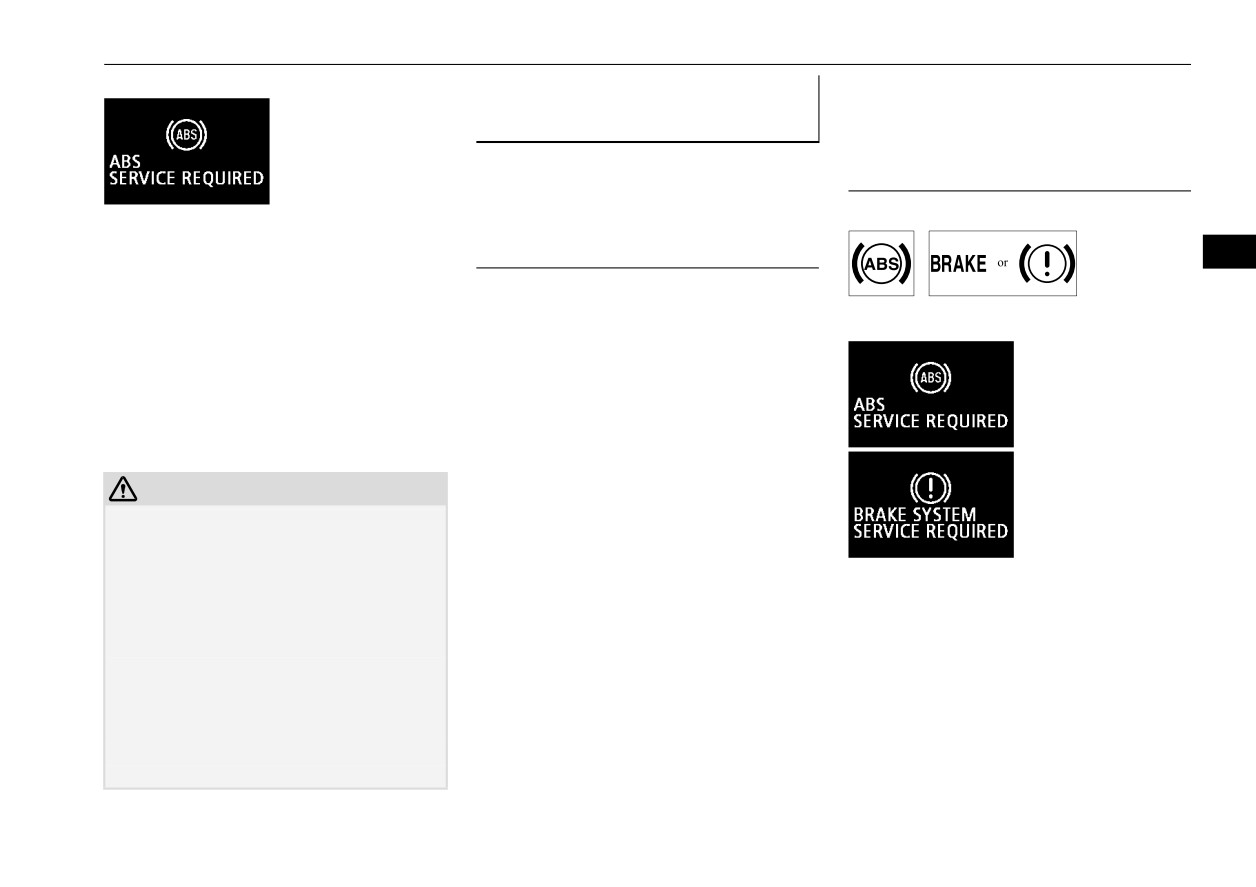
Anti-lock braking system
Warning display
If the warning light/display illu-
If the anti-lock braking system
minate while driving
warning light/display and brake
N00531701685
warning light/display illuminate at
the same time
If only the anti-lock braking sys-
Warning light
tem warning light/display illumi-
If there is a malfunction in the system, the
nate
anti-lock braking system warning light will
5
come on and the warning display will appear
z
Avoid hard braking and high-speed driv-
on the information screen in the multi-infor-
ing. Stop the vehicle in a safe place.
mation display.
Warning display
Test the system by restarting the engine
Under normal conditions, the ABS warning
and driving at a speed of about 12 mph
light only comes on when the ignition switch
(20 km/h) or higher.
is turned to the “ON” position or the opera-
If the warning light/display then remains
tion mode is put in ON and goes off a few
off during driving, there is no abnormal
seconds later.
condition.
However, if the warning light/display do
CAUTION
not disappear, or if they come on again
z
Any of the following indicates that the anti-
when the vehicle is driven, have the vehi-
lock braking system is not functioning and
cle checked by an authorized Mitsubishi
only the standard brake system is working.
Motors dealer or repair facility of your
(The standard brake system is functioning
choice as soon as possible.
The anti-lock braking system and brake force
normally.) If this happens, take your vehicle
distribution function may not work, so hard
to an authorized Mitsubishi Motors dealer or
braking could make the vehicle unstable.
a repair facility of your choice.
Avoid hard braking and high-speed driving.
• When the ignition switch is turned to the
Stop the vehicle in a safe place and contact an
“ON” position or the operation mode is put
in ON, the warning light does not come on
authorized Mitsubishi Motors dealer or repair
or it remains on and does not go off.
facility of your choice.
• The warning light comes on while driving
• The warning display appears while driving
Features and controls
5-71

Electric power steering system (EPS)
NOTE
Rear
WARNING
z The anti-lock braking system warning light
z Do not stop the engine while the vehicle is
and brake warning light illuminate at the
moving. Stopping the engine would make
same time and the warning displays appear
the steering wheel extremely hard to turn,
alternately on the information screen in the
possibly resulting in an accident.
multi-information display.
NOTE
5
After driving on icy roads
z
During repeated full-lock turning of the
N00529200077
steering wheel (for example, while you are
manoeuvring the vehicle into a parking
After driving on snow or icy roads, remove
space), a protection function may be acti-
any snow and ice which may have be left
vated to prevent overheating of the power
around the wheels. On vehicles that have an
Electric power steering sys-
steering system. This function will make the
anti-lock braking system, be careful not to
steering wheel gradually harder to turn. In
tem (EPS)
damage the wheel speed sensors (A) or the
this event, limit your turning of the steering
N00568401143
cables located at each wheel.
wheel for a while. When the system has
The power steering system operates while the
cooled down, the steering effort will return
engine is running. It helps reduce the effort
to normal.
Front
needed to turn the steering wheel.
z
If you turn the steering wheel while the vehi-
The power steering system has mechanical
cle is stationary with the headlights on, the
steering capability in case the power assist is
headlights may become dim. This behavior
lost. If the power assist is lost for some rea-
is not abnormal. The headlights will return to
their original brightness after a short while.
son, you will still be able to steer your vehi-
cle, but you will notice it takes much more
effort to steer. If this happens, have your vehi-
cle inspected at an authorized Mitsubishi
Motors dealer or a repair facility of your
choice.
5-72
Features and controls
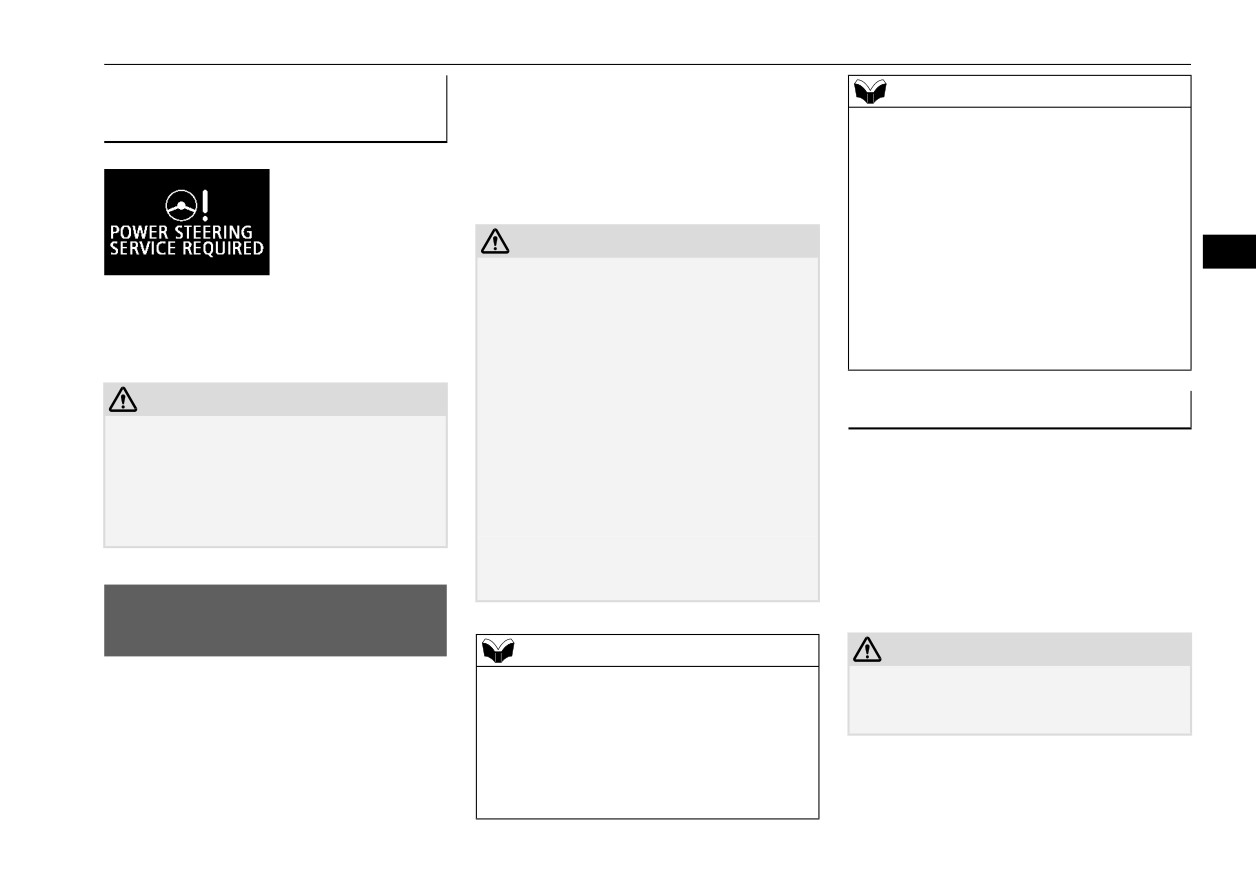
Active stability control (ASC)
ing system, traction control function and skid
Electric power steering system
NOTE
control function.
warning display
• When the ignition switch is turned to the
“ON” position or the operation mode is put
Anti-lock braking system P.5-70
in ON.
Traction control function P.5-73
• When the vehicle is driven for a while after
Skid control function P.5-74
the engine is turned on.
z
When the ASC is activated, you may feel a
CAUTION
vibration in the vehicle body or hear a whin-
5
z
Do not over-rely on the ASC. Even the ASC
ing sound from the engine compartment.
cannot prevent the natural laws of physics
This indicates that the system is operating
If there is a malfunction in the system, the
from acting on the vehicle. This system, like
normally. It does not indicate a malfunction.
warning display will appear on the informa-
any other system, has limits and cannot help
z
When the anti-lock braking system warning
tion screen in the multi-information display.
you to maintain traction and control of the
light is illuminated, the ASC is not active.
vehicle in all circumstances. Reckless driv-
ing can lead to accidents. It is the driver’s
CAUTION
responsibillty to drive carefully, This means
Traction control function
z If the warning display appears while the
taking into account the traffic, road and envi-
N00559200076
engine is running, have the vehicle inspected
ronmental conditions.
On slippery surfaces, the traction control
by an authorized Mitsubishi Motors dealer or
z
Be sure to use the same specified type and
a repair facility of your choice as soon as
function prevents the drive wheels from spin-
size of tire on all four wheels. Otherwise, the
possible. It may become harder to turn the
ning excessive, thus helping the vehicle to
ASC may not work properly.
steering wheel.
start moving from a stopped condition. It also
z
Do not install any aftermarket limited slip
provides sufficient driving force and steering
differential (LSD) on your vehicle. The ASC
performance as the vehicle turns while press-
may stop functioning properly.
ing the acceleration pedal.
Active stability control
(ASC)
NOTE
CAUTION
N00559100134
z
An operation noise may be emitted from the
z When driving a vehicle on a snowy or icy
The Active stability control
(ASC) takes
engine compartment in the following situa-
road, be sure to install snow tires and drive
overall control of the anti-lock braking sys-
tions. The sound is associated with checking
the vehicle at moderate speeds.
tem, traction control function and skid control
the operations of the ASC. At this time, you
function to help maintain the vehicle’s control
may feel a shock from the brake pedal if you
and traction. Please read this section in con-
depress it. These do not indicate a malfunc-
junction with the page on the anti-lock brak-
tion.
Features and controls
5-73
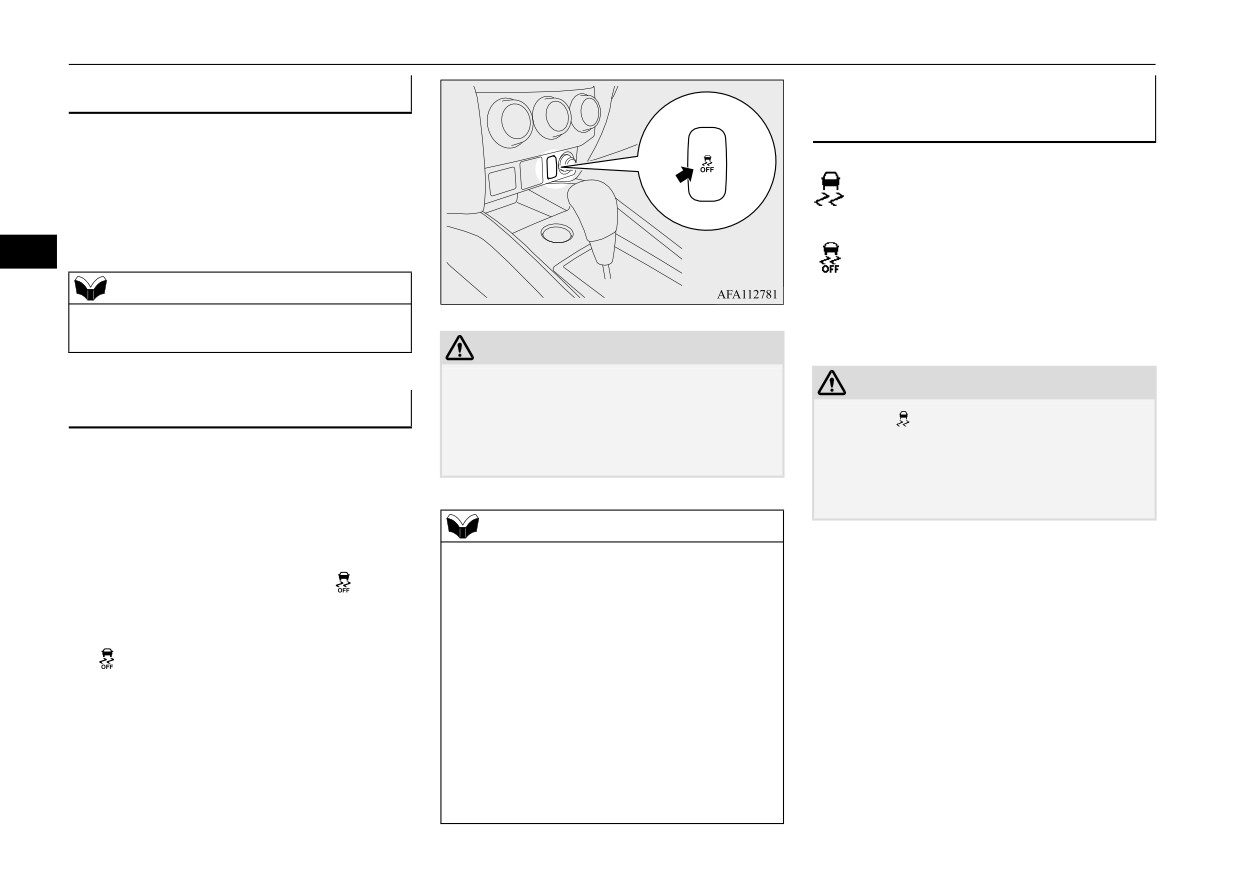
Active stability control (ASC)
Skid control function
ASC operation display or ASC
N00559300051
OFF display
The skid control function is designed to help
N00546501157
the driver maintain control of the vehicle on
slippery roads or during rapid steering
- ASC operation display/ASC indicator
The display/indicator will blink when
maneuvers. It works by controlling the engine
the ASC is operating.
output and the brake on each wheel.
5
- ASC OFF indicator
This indicator will turn on when the
NOTE
ASC is turned off with the
“ASC
z The skid control function operates at speeds
OFF” switch.
of about 9 mph (15 km/h) or higher.
CAUTION
z
For safety reasons, the “ASC OFF” switch
CAUTION
should be operated when your vehicle is
ASC OFF switch
stopped.
z
When
display/indicator blinks, ASC is
N00559401352
z
Be sure to keep the ASC on while driving in
operating, which means that the road is slip-
The ASC is automatically activated when the
normal circumstances.
pery or that your vehicle’s wheels are begin-
ignition switch is turned to the “ON” position
ning to slip. If this happens, drive slower
or the operation mode is put in ON. You can
with less accelerator input.
deactivate the system by pressing down the
NOTE
“ASC OFF” switch for 3 seconds or longer.
z
Using the “ASC OFF” switch turns off both
the stability control function and the traction
When the ASC is deactivated, the
indica-
control function.
tor will turn on. To reactivate the ASC,
z
When moving out of mud, sand or fresh
momentarily press the “ASC OFF” switch;
snow, pressing the accelerator pedal may not
the
indicator is turned off.
allow the engine speed to increase. In such
situations, temporarily turning off ASC with
the “ASC OFF” switch will make it easier to
move out your vehicle.
z
If you continue to press the
“ASC OFF”
switch after the ASC is turned off, the “mis-
taken operation protection function” will
activate and the ASC will turn back on.
5-74
Features and controls
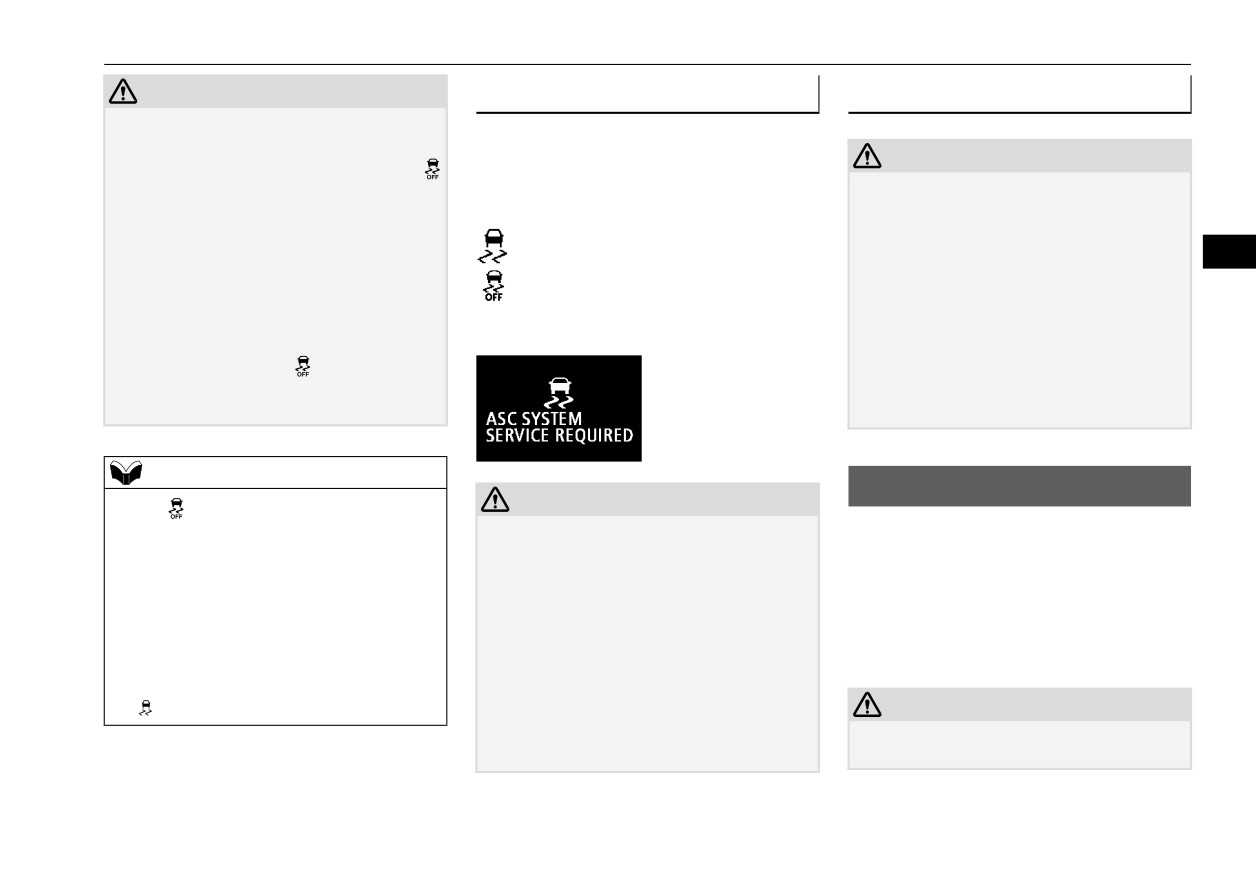
Cruise control
CAUTION
ASC warning display
Towing
z
If the temperature in the braking system con-
N00546601190
N00546300031
tinues to increase due to continuous brake
If an abnormal condition occurs in the sys-
CAUTION
control on a slippery road surface, the
tem, the following display/indicator will turn
z When towing the vehicle with only the front
indicator will blink. To prevent the brake
on.
wheels or only the rear wheels raised off the
system from overheating, the brake control
ground, do not place the ignition switch in
of the traction control function will be tem-
- ASC indicator
the “ON” position or do not put the operation
porarily suspended.
5
mode in ON. Placing the ignition switch in
The engine control of the traction control
- ASC OFF indicator
the “ON” position or putting the operation
function and normal brake operation will not
mode in ON could cause the ASC to operate,
be affected. Park your vehicle in a safe place.
resulting in an accident.
When the temperature in the braking system
Warning display
Note that the correct towing method depends
has come down, the
indicator will be
on the transmission type and the vehicle’s
turned off and the traction control function
drive configuration.
will start operating again.
For details, refer to “Towing” on page 8-12.
NOTE
Cruise control
z The
indicator may turn on when you start
CAUTION
N00518301727
the engine. This means that the battery volt-
z The system may be malfunctioning.
Cruise control is an automatic speed control
age momentarily dropped when the engine
Park your vehicle in a safe place and stop the
system that keeps a set speed. It can be acti-
was started. It does not indicate a malfunc-
engine.
Restart the engine and check whether the dis-
vated at speeds from approximately 25 mph
tion, provided that the display goes out
play/indicator goes out. If they go out, there
(40 km/h). Cruise control does not work at
immediately.
is no abnormal condition. If they do not go
speeds below approximately
25 mph
z When a compact spare tire has been put on
out or appear frequently, it is not necessary
(40 km/h).
your vehicle, the gripping ability of the tire
to stop the vehicle immediately, but you
will be lower, making it more likely that the
should have your vehicle inspected by an
display/indicator will blink.
CAUTION
authorized Mitsubishi Motors dealer or a
repair facility of your choice as soon as pos-
z When you do not wish to drive at a set speed,
sible.
turn off the cruise control for safety.
Features and controls
5-75
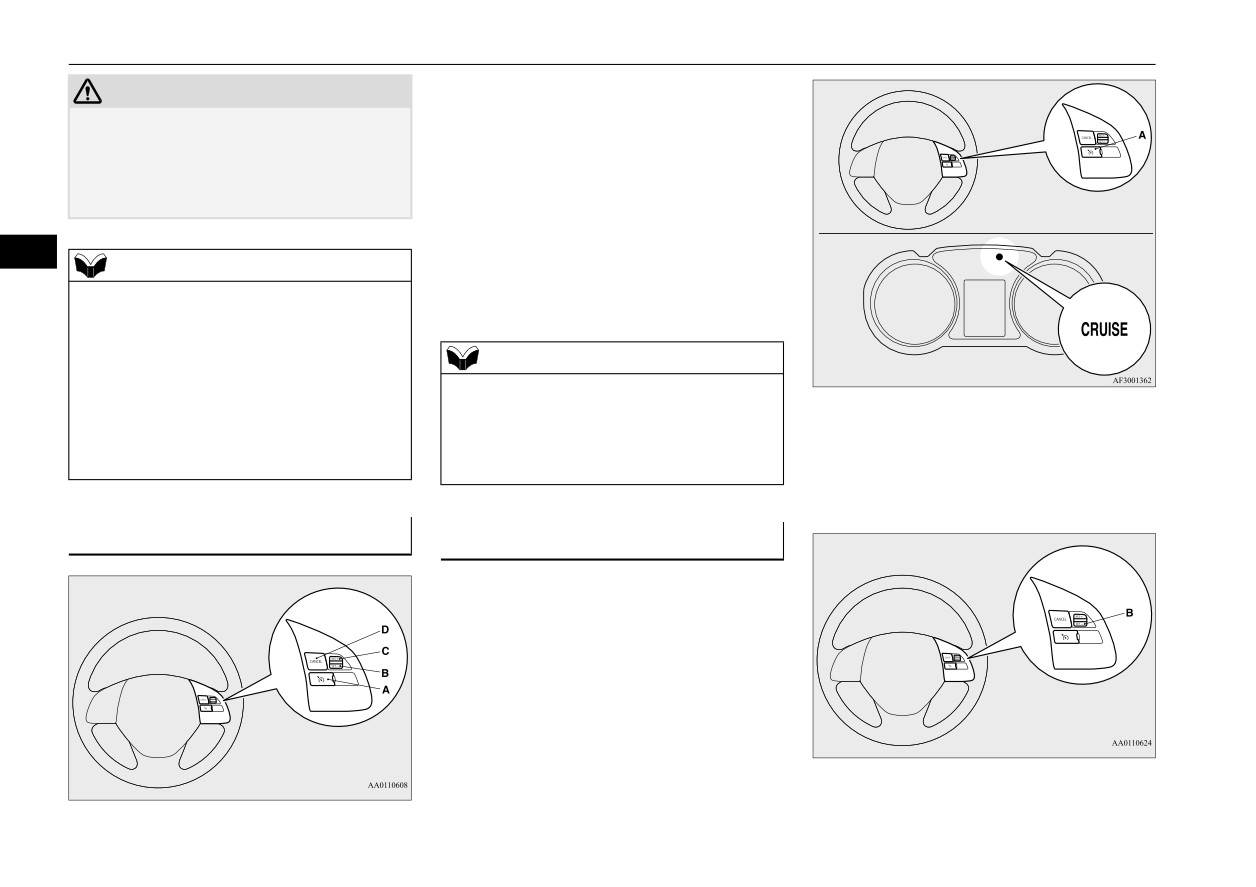
Cruise control
A- CRUISE CONTROL ON/OFF switch
CAUTION
Used to turn on and off the cruise control.
z
Do not use cruise control when driving con-
B-
SET - switch
ditions will not allow you to stay at the same
Used to reduce the set speed and to set the
speed, such as in heavy traffic or on roads
desired speed.
that are winding, icy, snow-covered, wet,
slippery, on a steep downhill slope.
C- RES + switch
Used to increase the set speed and to
return to the original set speed.
5
NOTE
D- CANCEL switch
z
Cruise control may not be able to keep your
Used to deactivate the set speed driving.
speed on uphills or downhills.
z
Your speed may decrease on a steep uphill.
You may use the accelerator pedal if you
NOTE
want to stay at your set speed.
z
When operating the cruise control switches,
z
Your speed may increase to more than the set
press the cruise control switches correctly.
speed on a steep downhill. You have to use
2. Accelerate or decelerate to your desired
The set speed driving may be deactivated
the brake to control your speed. As a result,
automatically if two or more switches of the
speed, then push down and release the
the set speed driving is deactivated.
cruise control are pressed at the same time.
SET - switch (B) when the “CRUISE”
indicator light is illuminated. The vehicle
will then maintain the desired speed.
Cruise control switches
To activate
N00518401513
1. With the ignition switch in “ON” position
or the operation mode is in ON, press the
CRUISE CONTROL ON/OFF switch (A)
to turn on the cruise control. The
“CRUISE” indicator light in the meter
cluster will come on.
5-76
Features and controls
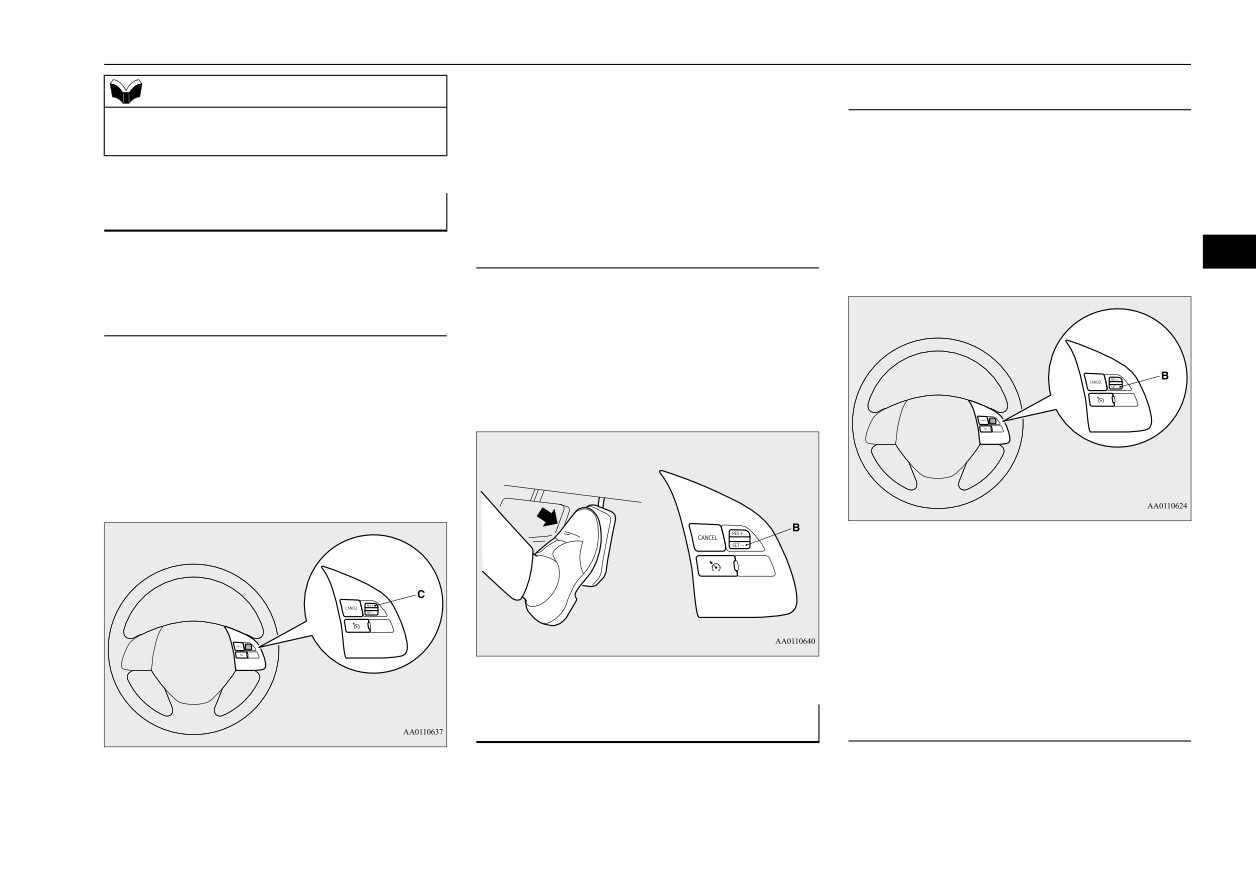
Cruise control
To increase your speed in small amounts,
NOTE
SET - switch
push up the RES + switch for less than about
z When you release the SET - switch, the vehi-
1 second and release it.
cle speed will be set.
Push down and hold the SET - switch (B)
Each time you push up the RES + switch,
while driving at the set speed, and your speed
your vehicle will go about 1 mph (1.6 km/h)
will slow down gradually.
faster.
To increase the set speed
When you reach your desired speed, release
N00518501367
the switch. Your new cruising speed is now
Accelerator pedal
set.
5
There are 2 ways to increase the set speed.
While driving at the set speed, use the accel-
RES + switch
erator pedal to reach your desired speed and
then push down the SET - switch (B) and
Push up and hold the RES + switch (C) while
release the switch momentarily to set a new
driving at the set speed, and your speed will
desired cruising speed.
then gradually increase.
When you reach your desired speed, release
the switch. Your new cruising speed is now
set.
To slow down your speed in small amounts,
push down the SET - switch for less than
about 1 second and release it.
Each time you push down the SET - switch,
your vehicle will slow down by about 1 mph
(1.6 km/h).
To decrease the set speed
Brake pedal
N00518601296
There are 2 ways to decrease the set speed.
While driving at the set speed, use the brake
pedal, which disengages the cruise control,
Features and controls
5-77
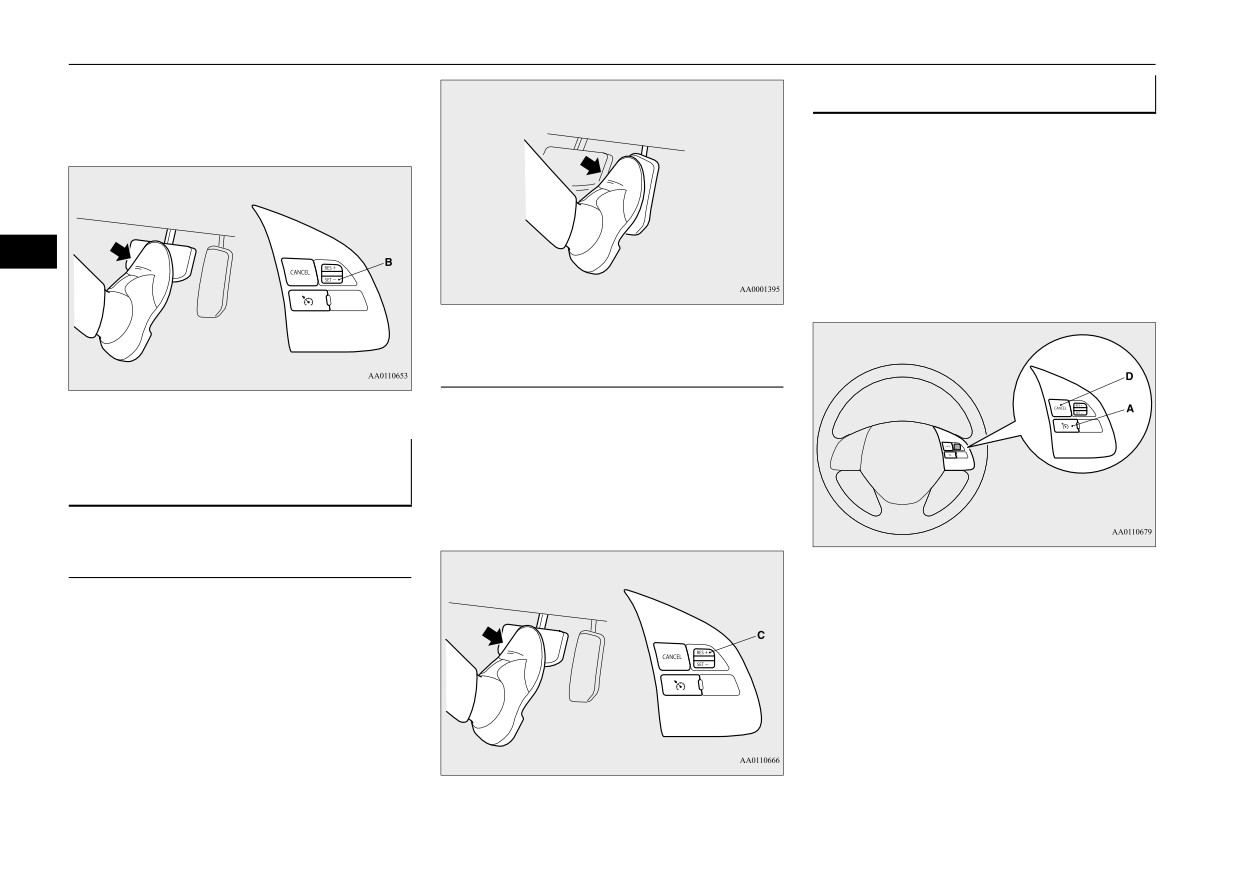
Cruise control
then push down the SET - switch (B) and
To deactivate
release the switch momentarily to set a new
N00518801692
desired cruising speed.
The set speed driving can be deactivated as
follows:
z Press the CRUISE CONTROL ON/OFF
switch (A). (Cruise control will be turned
5
off.)
z Press the CANCEL switch (D).
z Depress the brake pedal.
To temporarily decrease the speed
Depress the brake pedal to decrease the
speed. To return to the previously set speed,
To temporarily increase or
push up the RES + switch (C).
decrease the speed
Refer to “To resume the set speed” on page
N00541701079
5-79.
To temporarily increase the speed
The set speed driving is deactivated automati-
Depress the accelerator pedal as you would
cally in any of the following ways.
normally. When you release the pedal, you
will return to your set speed.
z When your speed slows to approximately
10 mph (15 km/h) or more below the set
speed because of a hill, etc.
z When your speed slows to approximately
25 mph (40 km/h) or less.
z When the active stability control (ASC)
starts operating.
5-78
Features and controls

Forward Collision Mitigation system (FCM) (if so equipped)
Refer to “Active stability control (ASC)”
Put the operation mode in OFF or ACC.
To resume the set speed
on page 5-73.
z “CRUISE” indicator light is turned OFF.
N00518901329
If the set speed driving is deactivated by any
WARNING
Forward Collision Mitiga-
condition described in
“To deactivate” on
z Although the set speed driving will be
page 5-78, you can resume the previously set
tion system (FCM) (if so
deactivated when shifting to the
“N”
speed by pushing up the RES + switch (C)
(NEUTRAL) position, never move the
equipped)
while driving at a speed of about 25 mph (40
selector lever to the
“N” (NEUTRAL)
N00577300082
km/h) or higher.
5
position while driving.
You would have no engine braking and
The Forward Collision Mitigation system
could cause a serious accident.
(FCM) is designed to help reduce the risk of a
collision with a vehicle or a pedestrian
Also, the set speed driving may be deacti-
straight ahead of your vehicle. The FCM uses
vated as follows:
a sensor (A) to determine the distance and
relative speed to a vehicle and a pedestrian in
z When the engine speed rises and
front. The FCM is not designed as an auto-
approaches the tachometer’s red zone (the
matic driving system or as a collision avoid-
red-colored part of the tachometer dial).
ance system.
When your vehicle is approaching a vehicle
or a pedestrian straight-ahead in your path
CAUTION
and the FCM judges that there is the risk of a
z When the set speed driving is deactivated
Under either of the following conditions,
collision, the system will give audible and
automatically in any situation other than
however, using the switch does not allow you
visual warnings.
those listed above, there may be a system
to resume the previously set speed. In these
malfunction.
When the FCM judges that a collision with
situations, repeat the speed setting procedure:
Press the CRUISE CONTROL ON/OFF
the vehicle or the pedestrian straight-ahead is
switch to turn off the cruise control and have
imminent, the system will automatically
z The CRUISE CONTROL ON/OFF
your vehicle inspected by an authorized
apply moderate braking to warn you to apply
switch is pressed.
Mitsubishi Motors dealer or a repair facility
the brakes immediately.
of your choice.
z [Except for vehicles equipped with the
When the FCM judges that a collision with
F.A.S.T.-key]
the vehicle or the pedestrian straight-ahead is
Turn the ignition switch to the “OFF” or
highly unavoidable, the system will apply
“ACC” position.
emergency braking to reduce the severity of
[Vehicles equipped with the F.A.S.T.-key]
Features and controls
5-79
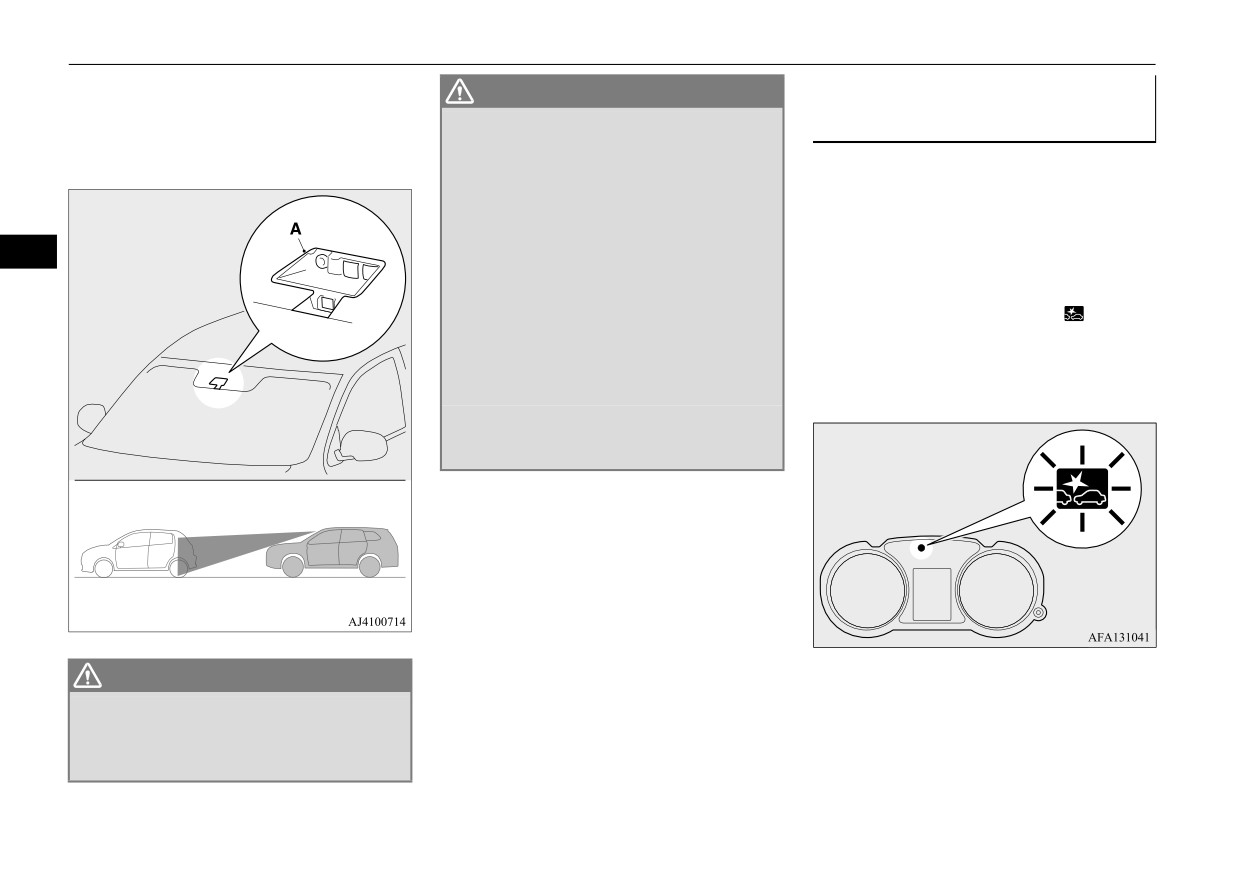
Forward Collision Mitigation system (FCM) (if so equipped)
the collision and, if possible, to avoid the col-
WARNING
Forward collision warning
lision.
z
The FCM is designed to help avoid certain
function
Stop lights are illuminated during automatic
frontal collisions or reduce the crash
braking.
N00577400100
speed in such collisions. It is not a substi-
If the system judges that there is a risk of
tute for your safe and careful driving.
your vehicle colliding with a vehicle or the
Under certain circumstances, the system
pedestrian in front, this function warns you of
may not operate or may not detect cor-
the potential hazard with visual and audible
rectly a vehicle or a pedestrian in front.
5
alarms.
When your vehicle is approaching a vehi-
cle or a pedestrian too closely, take all nec-
When this function is triggered, a buzzer
essary actions to avoid a collision, such as
sounds and, at the same time, the
indicator
braking and steering, regardless of
flashes.
whether the FCM is activated or not.
The FCM will also prepare to provide quick
Never rely on the FCM to prevent a colli-
brake response and greater brake force when
sion.
you apply the brakes.
z
Never attempt to test the operation of the
FCM. Doing so could cause an accident,
resulting in serious injury or death.
WARNING
The forward collision warning function oper-
z Before using the FCM, read this entire
ates at the following vehicle speeds:
section to fully understand the limitations
z Against a vehicle: Approximately 10 mph
of this system. Failure to follow instruc-
tions could result in an accident.
(15 km/h) to 87 mph (140 km/h).
z Against a pedestrian: Approximately
5
mph (7 km/h) to 40 mph (65 km/h).
5-80
Features and controls

Forward Collision Mitigation system (FCM) (if so equipped)
FCM braking function
WARNING
WARNING
N00577700158
z
If the ASC is turned off, the FCM braking
• When a vehicle ahead is not completely
When the FCM judges that a collision with
function will not operate. Refer to “Active
in your path.
the vehicle or the pedestrian straight-ahead is
stability control” on page 5-73.
• When your vehicle changed lanes, and
imminent, the FCM will automatically apply
z
If the brake pedal is not depressed within
your vehicle approached immediately
moderate braking to warn the driver to apply
2 seconds after your vehicle has been
behind the vehicle ahead.
stopped by the FCM, a warning buzzer
• When a vehicle ahead is towing a trailer.
the brakes immediately.
will sound and the brakes activated by the
• When a vehicle ahead is a truck loaded
If the FCM judges that the collision is highly
5
FCM will automatically be released.
with freight that protrudes rearward
unavoidable, it will automatically apply
Apply the brakes as necessary to keep
from the cargo bed.
emergency braking to reduce the severity of
your vehicle stationary.
• When the height of a vehicle ahead is
the collision and, if possible, to avoid the col-
z
The FCM will not activate and will not
extremely low or its road clearance is
lision.
provide either warning or braking in cer-
extremely high.
When the FCM applies emergency braking, a
tain situations. Some of these include:
• When a vehicle ahead is extremely dirty.
warning message is displayed in the informa-
• When the selector lever is in the “P”
• When a vehicle ahead is covered with
tion screen of the multi-information display.
(PARK) or “R” (REVERSE) position.
snow.
• When an object other than a vehicle or a
• When a vehicle ahead has a large glass
pedestrian is in front.
surface.
• When the FCM has detected a problem
• When a vehicle ahead does not have
in the system.
reflectors (light reflector) or the position
• When a vehicle or a pedestrian suddenly
of the reflector is low.
cuts in front of your vehicle.
• When a vehicle ahead is a car carrier or
The FCM braking function operates at the
z
The FCM may or may not detect a motor-
a similar shaped vehicle.
following vehicle speeds:
cycle, bicycle or wall depending on the sit-
• When accelerating and decelerating
uation. The FCM is not designed to detect
quickly.
z Against a vehicle: Approximately 3 mph
these objects.
• When driving on a slippery road covered
(5 km/h) to 50 mph (80 km/h)
z
The forward collision warning function
by rain water, snow, ice, etc.
z Against a pedestrian: Approximately
and/or the FCM braking function may not
• When driving on a road with alternating
3 mph (5 km/h) to 40 mph (65 km/h)
activate in certain situations. Some of
up and down steep slopes.
these include:
• When driving on a curve.
• When a vehicle suddenly appears just in
• When driving on a bumpy or rough road.
front of your vehicle.
• When driving in dark areas, such as in a
• When a vehicle cuts into your path at a
tunnel or at night.
close distance.
Features and controls
5-81

Forward Collision Mitigation system (FCM) (if so equipped)
WARNING
WARNING
WARNING
• When the system recognizes driver’s
• If the pedestrian is wearing loose-fitting
• When driving on a curve.
steering, accelerating, braking or gear
clothes.
• When there is a road side object (B) that
shifting actions as evasive actions to
• If part of a pedestrian’s body is hidden,
reflects the radar sensor signal, such as a
avoid collision.
such as when holding an umbrella, large
road sign.
• When the rear of your vehicle is weighed
bag, etc.
down with the weight of passengers and
• If a pedestrian bends forward, sits or lies
luggage.
on the road.
5
• Up to several seconds after starting driv-
• When a pedestrian is pushing/pulling
ing.
something, such as a stroller, bicycle or
• In adverse weather conditions, such as
wheelchair.
rain, snow, fog or sand-storm.
• When pedestrians gather in a group.
• When the windshield of the sensor por-
• When a pedestrian clothing appears to
• When approaching a gate, a railroad
tion is covered with dirt, water droplets,
be nearly the same color or brightness as
crossing, an underpass, a narrow bridge,
snow and ice, etc.
its surroundings.
manhole lid or a speed bump.
• When a vehicle ahead or an oncoming
• When a pedestrian is very close to an
• When driving under an overpass or
vehicle is splashing water, snow or dirt.
object, such as a vehicle.
pedestrian bridge.
• When using a windshield washer.
• When a pedestrian is in a dark area, such
• When driving in a narrow tunnel.
• If windshield wipers are not Mitsubishi
as at night or in a tunnel.
• When driving in a parking structure.
Motors Genuine parts or equivalent.
• When a pedestrian is walking fast or
• When approaching a slope where the
• When the sensor becomes extremely hot
running.
incline changes significantly.
or cold.
• When a pedestrian suddenly rushes in
• When trying to stop your vehicle very
• If the battery becomes weak or runs
front of the vehicle.
close to a vehicle or an object in front.
down.
• When the position of a pedestrian is close
• When passing a vehicle, a pedestrian or
• When the sensor is affected by strong
to the edge of the vehicle.
an object closely.
light, such as direct sunlight or the head-
z
When the system recognizes driver’s
lights of an oncoming vehicle.
steering or accelerating actions as evasive
z
The FCM may not detect a pedestrian in
actions to avoid a collision, FCM control
certain situations. Some of these include:
and alarm functions may be canceled.
• If the pedestrian is shorter than approxi-
z
In certain situations, though there is little
mately
3.2 feet
(1 m) or taller than
or no risk of a collision, the FCM may
approximately 6.5 feet (2 m).
activate. Examples include:
• When overtaking a vehicle.
5-82
Features and controls

Forward Collision Mitigation system (FCM) (if so equipped)
WARNING
WARNING
FCM ON/OFF switch
• When a vehicle in the next lane becomes
• When your vehicle is towed or your vehi-
N00577800159
positioned directly in front of your vehi-
cle tows another vehicle.
This switch is used to turn on or off the FCM,
cle due to winding
road conditions.
• When your vehicle is carried on a truck.
and also to select the distance which will trig-
• When your vehicle is on a chassis dyna-
ger the forward collision warning function.
mometer or free rollers.
• If the windshield on or surrounding the
sensor is cracked or scratched.
5
NOTE
• When passing through an area that
z
When depressing the brake pedal while auto-
objects may contact the vehicle, such as
matic braking is applied, the brake pedal will
thick grass, tree branches, or a banner.
feel firm. This is normal. Depress the brake
• When there are patterns on the road that
pedal harder to apply greater braking force.
may be mistaken for a vehicle or a pedes-
z
During the automatic braking, operating
trian.
sounds may be heard. This is normal.
• When a vehicle cuts into your path in the
detecting range of the sensor.
• When an oncoming vehicle is positioned
straight ahead of your vehicle on a
curved road.
• When the FCM detects a long object car-
ried on your vehicle, such as skis or a
roof carrier.
• When driving through fog, steam, smoke
or dust.
z
The FCM should be tuned off if any of the
following situations occur:
• When using an automatic car wash.
• When the tires are not properly inflated.
• When the emergency spare tire is used.
Features and controls
5-83

Forward Collision Mitigation system (FCM) (if so equipped)
Distance mode: Near
To turn on/off the FCM
To change forward collision warn-
ing distance
Every time the ignition switch is turned to the
“ON” position or the operation mode is put in
The distance to the vehicle ahead which trig-
ON, the FCM will automatically be turned
gers the forward collision warnings can be
on.
selected from three levels
(far, middle or
To turn off the FCM, press and hold the FCM
near).
ON/OFF switch. The following message
NOTE
5
To change the distance mode, push the FCM
appears on the information screen of the
z Actual distance which triggers the forward
ON/OFF switch. Every time the switch is
collision warnings will vary depending on
multi-information display and the
indica-
pushed, the distance mode will be switched.
your vehicle speed and the front vehicle
tor will come on in the instrument cluster.
The selected distance mode is shown on the
speed. The distance will become longer
information screen of the multi-information
when the vehicle speeds are higher.
display.
z The distance which will trigger the FCM
braking function cannot be adjusted.
Distance mode: Far
System problem warning
To turn on the FCM again, press the FCM
N00593300064
ON/OFF switch. The
indicator on the
If there is a malfunction in the system, a
instrument cluster will go off, and a current
warning will appear on the information
distance mode for the forward collision warn-
Distance mode: Middle
screen of the multi-information display
ing will be shown in the information screen
depending on the situation.
of the multi-information display.
Windshield is dirty
When the FCM system determines that its
performance has been degraded, the FCM
will become inoperative.
This can occur when:
5-84
Features and controls

Forward Collision Mitigation system (FCM) (if so equipped)
z Foreign objects, such as dirt, snow, ice,
NOTE
Sensor is too hot or cold
mist or dew condensation adhere to the
z The “CAMERA BLOCKED” message may
windshield of the sensor portion.
If the system becomes temporarily unavail-
appear on the information screen when driv-
z In adverse weather conditions, such as
ing on a nonbusy road with a few vehicles
able due to the high or low temperature of the
rain, snow, sand storms, etc.
and obstacles in front.
sensor, the following message will appear on
z A front vehicle or an oncoming vehicle is
the information screen of the multi-informa-
splashing water, snow or dirt.
When the system cannot operate
tion display, the
indicator will come on in
the instrument cluster, and the FCM will
5
The following message will appear on the
temporarily
automatically be turned off.
information screen of the multi-information
If the system becomes temporarily unavail-
display and the
indicator will come on in
able for some reason, the following message
the instrument cluster.
will appear on the information screen of the
multi-information display, the
indicator
will come on in the instrument cluster, and
After the temperature of the sensor has been
the FCM will automatically be turned off.
in range, the system will automatically return
to operation.
When the sensor performance returns, the
If the message continues showing, there is a
FCM functions will resume operation.
possibility that the FCM has a malfunction.
If the message continues showing, there is a
Contact an authorized Mitsubishi Motors
possibility that the sensor has a malfunction.
dealer for inspection of the sensor.
If the message continues showing, there is a
Contact an authorized Mitsubishi Motors
possibility that the FCM has a malfunction.
dealer for inspection of the sensor.
Contact an authorized Mitsubishi Motors
dealer for inspection of the system.
NOTE
z The “CAMERA BLOCKED” message may
temporarily appear on the information screen
when the sensor cannot detect a vehicle, a
pedestrian or an object within range. This is
not a malfunction. When a vehicle or an
object comes within range, the FCM func-
tion will resume and the message will go off.
Features and controls
5-85
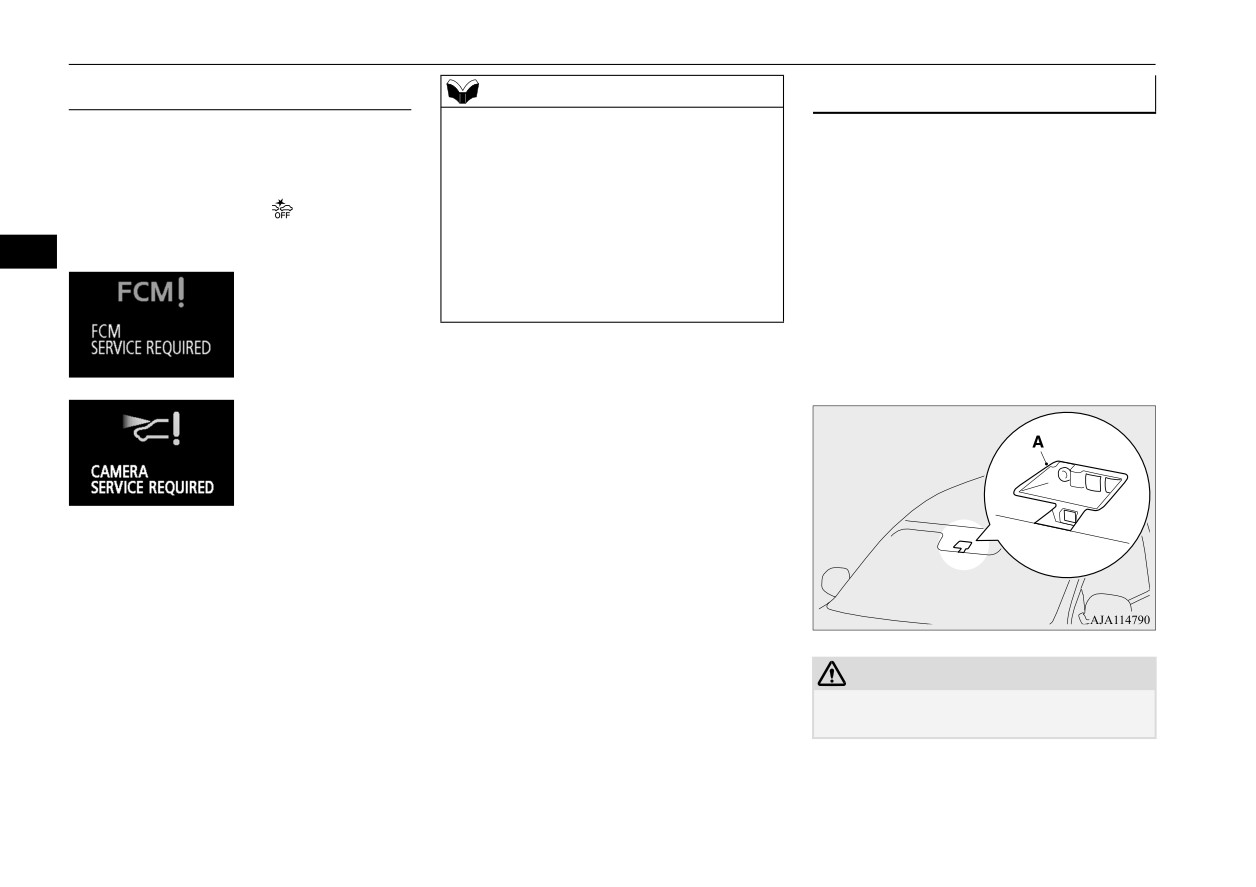
Forward Collision Mitigation system (FCM) (if so equipped)
FCM deactivation due to fault
NOTE
Handling of the sensor
z If the sensor or its surrounding area becomes
N00593400108
If the FCM detects a malfunction in the sys-
extremely hot (after prolonged exposure to
The sensor (A) is located inside the wind-
tem, either of the following messages will
direct sunlight, for example), the
“FCM
shield as shown in the illustration.
appear on the information screen of the multi-
SERVICE REQUIRED” message may
The sensor is shared in the following sys-
appear.
information display, the
indicator will
tems:
After the temperature of the sensor or its sur-
come on in the instrument cluster, and the
rounding area has been in range, if the mes-
z Forward Collision Mitigation
system
5
FCM will automatically be turned off.
sage remains even after restarting the engine,
(FCM) (if so equipped)
please contact an authorized Mitsubishi
z Lane Departure Warning (LDW) (if so
Motors dealer.
equipped)
z Automatic High Beam
(AHB)
(if so
equipped)
If the message remains even after the ignition
switch is turned to the “OFF” position and
then turned back to “ON” position or the
operation mode is put in OFF, and then turned
back to ON, please contact your authorized
Mitsubishi Motors dealer.
CAUTION
z To maintain proper performance of the FCM,
LDW and AHB;
5-86
Features and controls
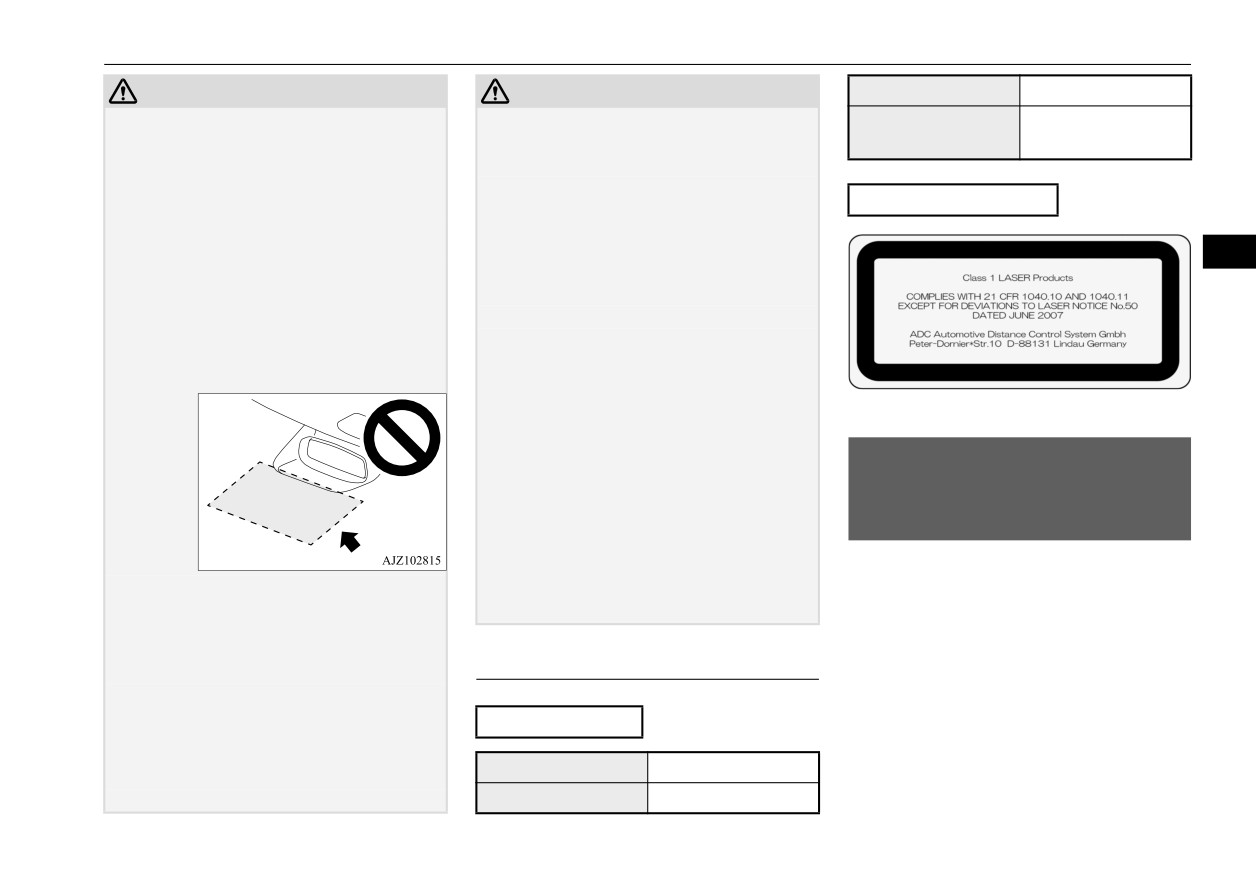
Blind Spot Warning (BSW) (with Lane Change Assist) (if so equipped)
Wavelength
905 nm
CAUTION
CAUTION
• Always keep the windshield clean.
• Do not spray glass cleaner on the sensor.
Divergent angle
28° x 12°
If the inside of the windshield where the
Also, do not spill liquid, such as a bever-
(horizon x vertical)
sensor is installed becomes dirty or fogged,
age, on the sensor.
contact an authorized Mitsubishi Motors
• Do not install an electronic device, such as
dealer.
an antenna, or a device that emits strong
Laser classification label
• Do not apply an impact or load on the sen-
electric waves, near the sensor.
sor or its surrounding area.
• Always use tires of the same size, same
5
• Do not put anything including a sticker or
type and same brand, and which have no
film to the outer side of windshield in front
significant wear differences.
of or surrounding the area of the sensor.
• Do not modify the vehicle’s suspensions.
Also, do not put anything including a
z
If the windshield in front of the sensor or in
sticker of film to inner side of the wind-
the surrounding area of the sensor is cracked
shield under the sensor.
or scratched, the sensor may not detect an
object properly. This could cause a serious
accident. Turn off the FCM and have your
vehicle inspected as soon as possible at an
authorized Mitsubishi Motors dealer.
Blind Spot Warning (BSW)
If you need to replace the windshield, con-
(with Lane Change Assist) (if
tact an authorized Mitsubishi Motors dealer.
z
The sensor emits infrared rays when the
so equipped)
operation mode is in ON. Do not look into
N00592200079
the sensor by using optical goods such as a
• Do not attempt to detach or disassemble the
magnifying glass. The infrared ray might
The Blind Spot Warning (BSW) is a driving
sensor.
injure your eyes.
aid system that alerts the driver when another
• If the windshield is misted, remove the mist
vehicle which may not be visible through the
from the windshield by using the defogger
outside rearview mirror is traveling in the
Laser radar specifications
switch.
next lane behind your vehicle.
• Maintain the wiper blades in good condi-
When a vehicle in the next lane is traveling at
tion. Refer to “Wiper blades” on page 9-40.
Laser classification
same speed or faster in the detection areas,
When replacing the wiper blades, use only
the Blind Spot Warning light in the corre-
Mitsubishi Motors Genuine parts or equiva-
Max average power
45 mW
sponding outside rearview mirror will illumi-
lent.
• Do not dirty or damage the sensor.
Pulse duration
33 ns
nate. If the turn signal lever is operated to the
Features and controls
5-87
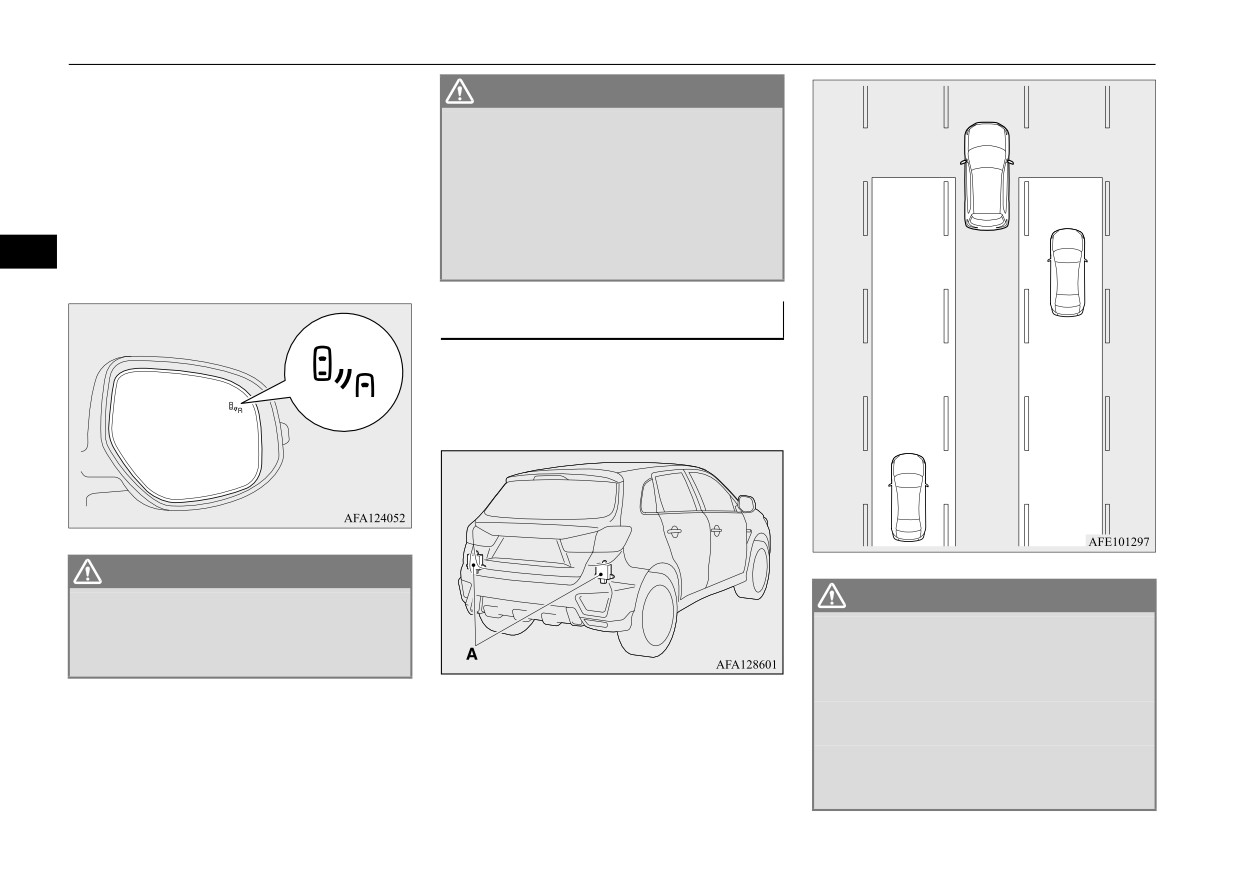
Blind Spot Warning (BSW) (with Lane Change Assist) (if so equipped)
side where the Blind Spot Warning light is
WARNING
illuminated, the Blind Spot Warning light will
z Never rely solely on the BSW system when
blink and the system will beep 3 times to alert
changing lanes. BSW is an aid only. It is
the driver.
not a substitute for your safe and careful
Depending on the relative speed between
driving. Always check visually behind and
your vehicle and a vehicle in the next lane,
all around your vehicle for other vehicles.
the BSW will detect up to approximately
The performance of the BSW may vary
230 feet
(70 m) from your vehicle
(Lane
depending on driving, traffic and/or road
5
Change Assist).
conditions.
Detection areas
N00592300126
The BSW uses 2 sensors (A) located inside
the rear bumper.
The detection areas are shown as illustrated.
WARNING
z Before using the BSW, read this entire sec-
WARNING
tion to fully understand the limitations of
z In certain situations, the BSW may not
this system. Failure to follow instructions
detect a vehicle in the detection areas or
could result in an accident.
the detection may be delayed. Some of
these include;
• When a small motorcycle or a bicycle is
behind your vehicle.
• When a vehicle is traveling alongside of
your vehicle at nearly the same speed for
prolonged periods of time.
5-88
Features and controls
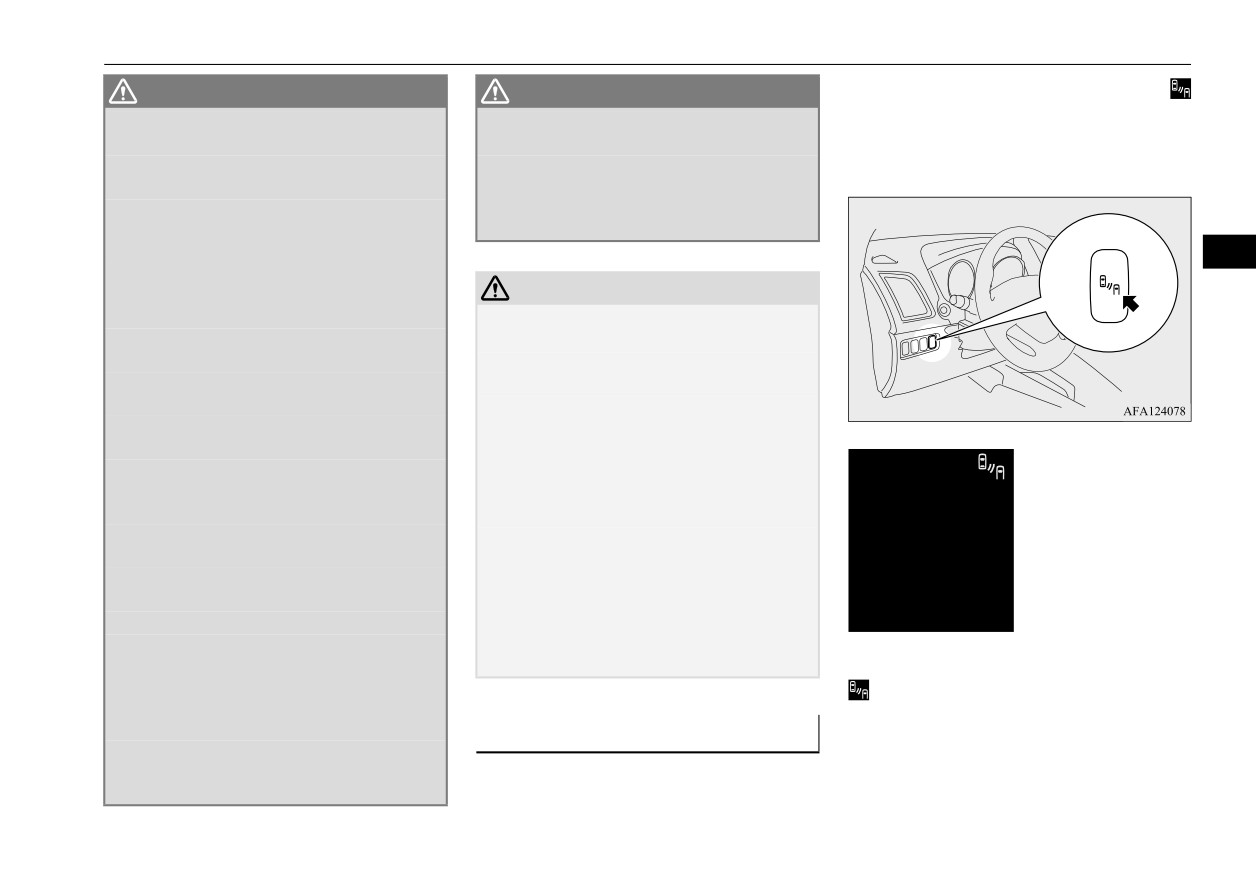
Blind Spot Warning (BSW) (with Lane Change Assist) (if so equipped)
or the operation mode is put in ON, the
WARNING
WARNING
indicator (green) will appear on the informa-
• When the heights of the next lane and
• When a bicycle carrier or accessory is
your lane are different.
installed to the rear of the vehicle.
tion screen of the multi-information display
• Immediately after the BSW has been
• When the sensor is extremely hot or cold
and the BSW will enter the standby state.
turned on.
(while the vehicle is parked for a long
• Immediately after the ignition switch is
period of time under a blazing sun or in
turned to the “ON” position or the oper-
cold weather).
ation mode is put in ON.
5
• Under adverse weather conditions, such
as rain, snow, strong winds, snow or sand
CAUTION
storm.
z
To maintain proper performance of the BSW,
• When your vehicle becomes too close to
follow the instructions below.
another vehicle.
• Always keep the bumper surface around the
• While multiple vehicles are overtaking
sensor clean.
your vehicle.
• Avoid impacting the sensor or its surround-
• When driving near a pot hole and tram-
ing area.
line.
• Do not put a sticker on the sensor or its sur-
• When a surrounding vehicle or an
rounding bumper surface.
oncoming vehicle is splashing water,
• Do not paint the sensor or its surrounding
snow or dirt.
bumper surface.
• When driving on a curve including the
• Do not modify the sensor or its surrounding
beginning and the end of the curve.
area.
• When driving on a road with alternating
z
If the bumper has experienced an impact, the
up and down steep slopes.
sensor may have been damaged and the BSW
• When driving on a bumpy or rough road.
may not function properly. Have the vehicle
• When the rear of your vehicle is weighed
inspected at an authorized Mitsubishi Motors
down or your vehicle is leaning to the
dealer.
When the BSW switch is pressed again, the
right or left due to the weight of passen-
indicator on the information screen of the
gers and luggage or the improper adjust-
multi-information display will then go out
ment of tire pressure.
To operate
and the BSW will turn off.
• When the bumper surface around the
N00593500141
radar sensor is covered with dirt, snow
and ice, etc.
When the BSW switch is pressed while the
ignition switch is turned to the “ON” position
Features and controls
5-89
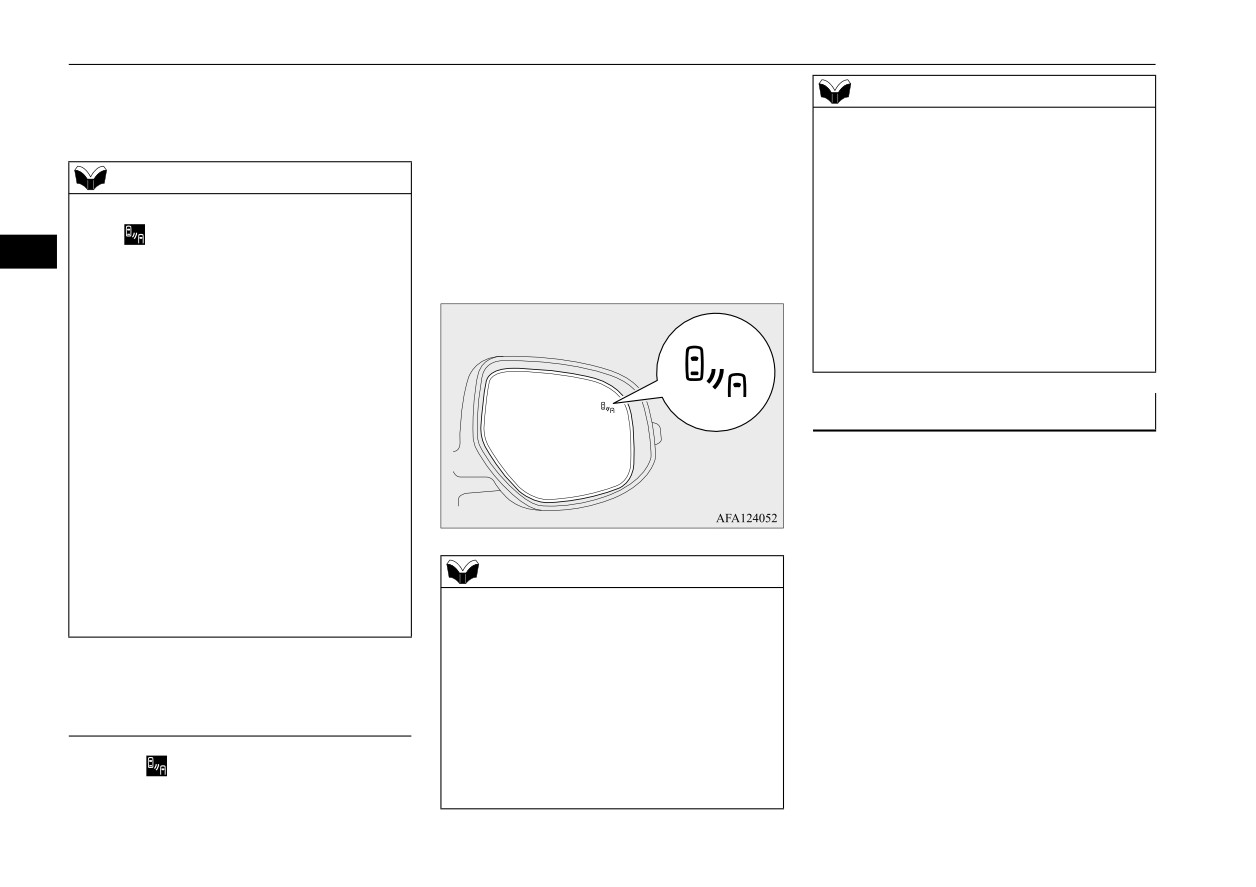
Blind Spot Warning (BSW) (with Lane Change Assist) (if so equipped)
If you turn the BSW ON/OFF, the Rear Cross
display, if a vehicle is approaching your vehi-
NOTE
Traffic Alert (RCTA) also turns ON/OFF at
cle in the detection area, the Blind Spot
• Under adverse weather conditions
(rain,
the same time.
Warning light in the outside rearview mirror
snow, sand storm etc.).
illuminates.
• When driving while your vehicle is blowing
If the turn signal lever is operated to the side
NOTE
up water, snow, sand, etc., on the road.
where the Blind Spot Warning light is illumi-
z
After the system check screen disappears,
• When driving near a curb, pot hole and
nated, the Blind Spot Warning light will blink
tramline.
the
indicator (green) appears on the infor-
and the system will beep 3 times to alert the
z
Set the BSW to OFF when towing.
5
mation screen of the multi-information dis-
driver.
z
The Blind Spot Warning light in the outside
play.
rearview mirror may not be visible due to
Refer to “Information screen (When the igni-
strong direct sunlight or the glare from the
tion switch is turned from the “OFF” posi-
headlights of vehicles behind you during
tion to the “ON” position or the operation
night driving.
mode is changed from OFF to ON)” on page
5-112.
z
When the operation mode is set to OFF, the
System problem warning
selected condition
(BSW ON/OFF) just
N00592400042
before setting to OFF is retained.
If a problem occurs with the system, a visual
z
The BSW operates when all of the following
conditions are met.
warning specific to the type of the problem is
• The ignition switch is turned to the “ON”
given together with an audible alarm.
position or the operation mode is put in ON.
The warnings are combined with the Rear
• The selector lever is in positions other than
Cross Traffic Alert (RCTA) system.
“P” (PARK) and “R” (REVERSE).
NOTE
• The speed of your vehicle is approximately
z
The Blind Spot Warning light in the outside
6 mph (10 km/h) or higher.
rearview mirror may come on or blink in the
following conditions.
• When driving very near the guardrail or the
concrete wall.
When the sensor detects an
• When driving near the entrance and outlet
approaching vehicle
of a tunnel or very near the wall or near the
evacuation area inside the tunnel.
When the indicator (green) appears on the
• When turning at an intersection in a town
information screen of the multi-information
area.
5-90
Features and controls